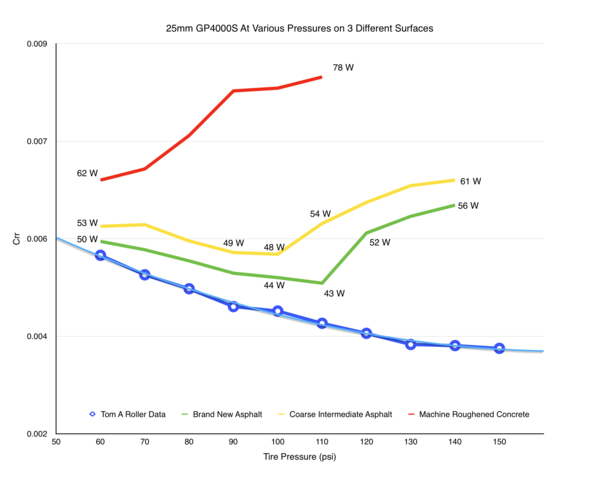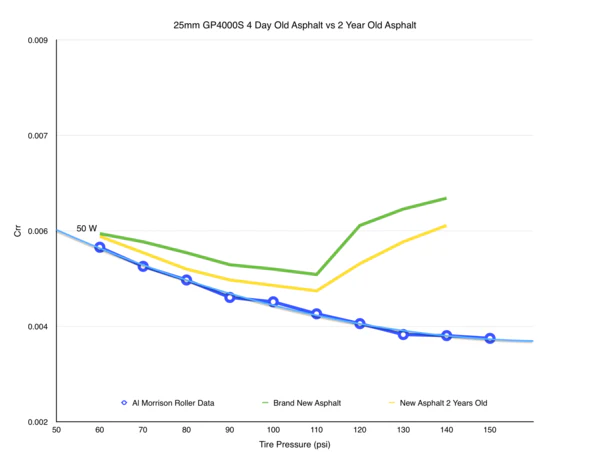I haven’t done a tire bake off on my wheels, but these guys did at two representative powers on nearby roads:
32 tires for the win, on my wheels.
I haven’t done a tire bake off on my wheels, but these guys did at two representative powers on nearby roads:
32 tires for the win, on my wheels.
Your communication does not make that clear. Your graph is about the reduction in rolling resistance, which has nothing to do with suspension losses. Rolling resistance and suspension losses are both components of the total resistance in the system… but they are not the same and they are not too closely related.
Note that suspension losses increase with pressure. This is an entirely different subject from rolling resistance. Read the nicely-explained article about “Why Wide Tires Are NOT Slower” for more details (posted just above by @Junk_Miles). There are plenty of other sources agreeing with that.
Your attitude is that there is a CLEARLY RIGHT answer favoring the narrower tire. What I’m saying is that the world agreed with you 10 years ago, but that there is, at the very least, much less agreement on that today… and I think it’s fair to say that the preponderance of experts will now recommend the wider tire.
And given how close the times were, I’d have personally chosen the 34mm tires for greater comfort… especially for “longer gran fondo type events” where the OP wants to balance performance with comfort.
The chart he posted included impedance loses. Did you look at the graph?
Nobody going to resolve differences until you take your wheels and tires outside and test.
That’s not the correct interpretation of that graph. See these tests for example:

I’m just going to link the post so I don’t add anything in my own words.
Of course I looked at it. But I noted the “Crr” Y axis and didn’t realize/remember that Josh uses impedance as synonymous with suspension, so I missed what he was saying. My mistake.
However… having reviewed it, I’ll note that his graph comes from the Silca blog’s Part 4B: Rolling Resistance and Impedance, where @Brennus has nicely picked the graph most favorable to his/her argument.
Further down the page is a graph clearly showing how increasing the surface imperfections favors lower pressures:

He also shows the breakpoint where “…we learned that Tom Anhalt’s data was repeatable, and impedance does in fact dominate the rolling resistance beyond the breakpoint pressure” (emphasis mine).
I very clearly do NOT see any mention of impedance in the initial arguments by @Brennus and the “I’m not ignoring it, I just know what it is” response clearly indicates a dismissal of its importance. But the same data source indicates its significant importance.
AND, this is all on 25mm tires which had a WAM of 25.8mm. Josh’s “breakpoint pressures” are between 70psi and 95psi depending on surface… but that’s on a pretty narrow tire. The breakpoint pressures where impedance dominates the rolling resistance would be much lower on a 28mm or 30mm tire.
Wider tires at lower pressures are KNOWN to have lower impedance losses since they flex more.
More supple tires are KNOWN to have lower total resistance (again, see graph on same page with caption “Tires with More Supple Casings Have Lower Rolling Resistance Everywhere and are More Forgiving of Over/Under Pressure”).
Links to two really great articles from the SILCA blog on all this:
I see NOTHING to indicate that “the data clearly support that choice [the 28mm tires] and […] the only argument for the 30mm tire is that you will ‘feel better’ after riding for a ‘long time’.”
Well, that’s just ridiculous. I’d have to ride my bike which is not part of my training program for getting faster by optimizing equipment in hypothetical scenarios.
There is no weight difference I have GP5000 in 28 and 30c and they weigh exactly the same.
Also on my regular route my fastest time was done on 30mm tyres
Any of you guys been outside for a ride today? Cabin fever abounds.
The widget says to use measured tire width so it accounts for rim inner width.
I’ve done my share of arguing for today, and I think this particular discussion has run its course as well. I’m going to take your advice and head outside.
I know you didn’t say it because everything I’ve told you is correct. That’s my point. Clear advantage for 28’s on that wheelset, just like I said. Even your own post agreed with my points. ;-D You’re just upset because somewhere you saw 28 and you thought some other numbers should be there & that’s the end of it. Maybe you should go for a ride on your real roads and calm down a little. Ha!
" He also shows the breakpoint where “…we learned that Tom Anhalt’s data was repeatable, and impedance does in fact dominate the rolling resistance beyond the breakpoint pressure”"
Negative. You are showing theoretical data. Impedance losses start at over 100 PSI. This is actual data from Silca. Not theoretical. Here is the Conti grand prix on asphalt:

So who is cherry picking charts, my friend? Heh.
“I very clearly do NOT see any mention of impedance in the initial arguments by @Brennus and the “I’m not ignoring it, I just know what it is” response clearly indicates a dismissal of its importance.”
Again, negative. I didn’t bring impedance into this thread. Another poster did by posting over and over again that BRR data is on a metal roller. I didn’t bring that up, somebody else did. I’m just saying I didn’t bring it up because I actually know what the data look like. You start to see impedance losses at higher pressures. I’m not talking about higher pressures. I showed you the pressures I’m talking about.
Did I say that? I don’t see anywhere in this thread where I said that. Are you making things up now?
![]()
You’re just upset because somewhere you saw 28
I can quote where you said 30. Actually, here you go:
At 80 psi, for example, the rolling resistance advantage of the 30’s will be measured on the order of 10’s of milliwatts. So, de minimus.
Honestly, at this point, after showing you the recommended psi for 30s, and even your own example proving you wrong with 28s, I’ve realized you’re just trolling. I have yet to see any evidence that 28s are “clearly better” and you seem to like arguing for arguments sake. Have fun on your 28s. Cheers.
these guys did at two representative powers on nearby roads
Yes that’s a great video! However, two critical things. First, the internal width on the wheelset in that video is very different from the OP wheelset. And the wheel depth. So not apples-to-apples.
Second, and here is where the average person who is into cycling gets thrown off…watch the video again…what do you not see? What do you not hear? Wind. No wind. Without seeing the yaw distribution of those rides it seems like it was mostly less than 5% for the whole ride.
Now, look at the 28 vs 30 comparison. It’s less than 2%. Which is just about the error of an orthogonal strain gauge array power meter. ![]() In fact, they even say that in the commentary…oh, maybe the difference is about the same on a percentage basis.
In fact, they even say that in the commentary…oh, maybe the difference is about the same on a percentage basis.
So, yeah, like I said AT YAW there is an aerodynamic disadvantage to running the foundation 45s with larger-than-manufacturer-recommended tires. Most rides are going to have a yaw distribution with negative kurtosis compared to the day shown in that video. And, of course, we can’t hold race day off until the wind dies down.
28s are “clearly better”
Agreed.
I must have missed it, where did we get the evidence that 28 was clearly better than 30?
Well, that’s just ridiculous. I’d have to ride my bike which is not part of my training program for getting faster by optimizing equipment in hypothetical scenarios.
Best. Post. #ThreadOver.
@AgingCannon im not arguing with @Brennus because that guy is a multi-sport beast.
Any of you guys been outside for a ride today? Cabin fever abounds.
Maybe on a cheap hotel bike, but I just hiked 3 miles thru palm oasis in SoCal and it was so windy on this ridge, in the shadow of an almost 11,000 foot mountain
That I had every yaw angle imaginable! My world for a bike and some 28 and 30 tires to test!
One of the things I love about cycling is the relentless debates you can witness over 2 mm of tire width.
But here’s a thought – what if you do both: 28 mm in the front and 30 mm in the back?